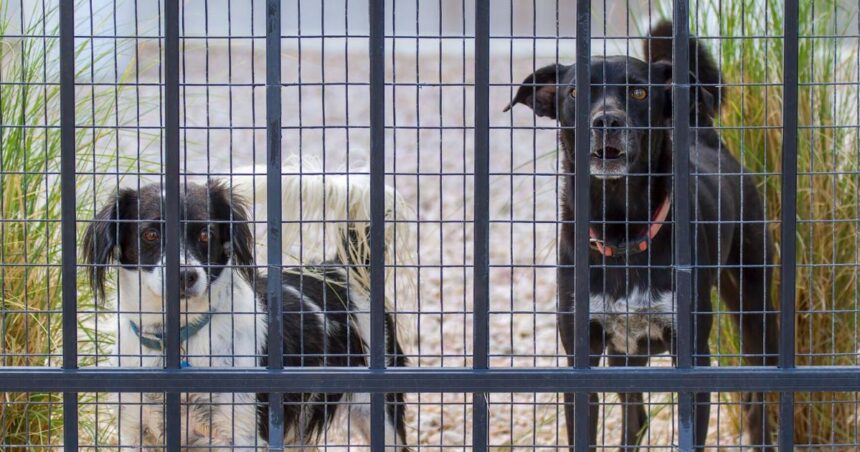Neighbors on both sides of our fence have dogs. Ours is a female; the other dogs are males. For some unknown reason, our Goldendoodle and their dogs behave aggressively toward each other through the fence.
None of the families can be in our backyards with our dogs simultaneously. Is there a safe way to socialize the dogs so they won’t be aggressive? I’ve been afraid to let them get too close because our dog has bitten a small dog.
Maggie, Virginia Beach, Virginia
Dealing with aggression between your Goldendoodle and the neighboring dogs requires a careful and systematic approach to ensure safety and foster positive interactions. Begin by assessing the situation to understand what triggers the behavior, whether it’s movement, noise, or visual contact through the fence.
People are also reading…
For instance, if the fence is see-through, adding a visual barrier can reduce the stimuli that provokes aggression. Sometimes, it’s because a wooden fence shakes when the dogs hit it. I once had a neighbor staple a roll of chicken wire across our entire shared fence line to discourage her dogs from attacking the fence — and it worked. It fortified the fence and made it less fun for them to attack it.
Here are some other things to try:
Generally, if you can get dogs on one side of the fence to not engage, the other dogs will cease to engage if they don’t get a reaction. On your side of the fence, begin training your dog to “leave it,” so you can call her back to you when she heads to the fence. Whenever she remains calm on her side of the fence, give her praise and treats. Ask your neighbors to do the same.
Parallel walking is another effective strategy. Arrange with your neighbors to walk the dogs parallel to each other on opposite sides of the street. As the dogs become more at ease with each other, close the gap until they are walking within five to 10 feet of each side-by-side, in a calm manner. If they get agitated again, increase the distance between them again.
When it’s time for a face-to-face meeting, choose a neutral location rather than either dog’s yard. Keep all dogs on leashes and start with a brief meeting. Initially keep them about 20 feet apart, allowing them to observe each other without interacting. Gradually decrease the distances and increase the time as they show signs of acceptance. Group obedience classes also help because it offers a controlled environment where dogs must learn to be around other dogs.
Allowing the aggression to persist, just ensures they will continue the behavior. So, until you’re confident the dogs can coexist peacefully, coordinate with your neighbors to have separate times in the backyard. Changing aggressive behavior takes time, so celebrate small improvements. If the aggression persists, however, consult a professional dog trainer or behaviorist with experience in aggressive behavior to guide you and tweak the process to ensure success.
I read your column in today’s Arizona Daily Star where a reader is asking for help for her dog who suffers when she hears loud noises. With my 14-year-old Chow/Staffie/Golden mix, who shakes, pants, paces, and drools when she hears fireworks, I tried everything mentioned in your column: acepromazine, calming chews, ThunderShirt®, Rescue Remedy®, and Trazadone.
I tried putting her in the bathroom, but she tore up the drywall trying to get out, so that lasted about five minutes. Weeks before the 4th of July, I tried playing a CD of fireworks and thunder, starting out very low and increasing the volume. She slept through it all. There is only one thing that works for her: Sileo, available only with a prescription from the vet. To me, this is a miracle drug that gives relief to terrified dogs.
— EFD, Tucson, Arizona.
There are so many options these days to help calm their noise-sensitive dogs, and Sileo is indeed one of those new products that I failed to mention. Sileo is a prescription-based product and is the first and only FDA-approved treatment for canine noise aversion.
Sileo works by blocking the release of norepinephrine, a brain chemical involved in the fight-or-flight response, which helps to calm the dog’s anxiety without sedating them. Administered as a gel between the dog’s gum and cheek, it is absorbed quickly and provides relief within 30 to 60 minutes and lasts several hours.
It’s great to hear that Sileo has been effective for your dog, as it can be a true lifesaver for pets that suffer from severe noise anxiety.
(Cathy M. Rosenthal is a longtime animal advocate, author, columnist and pet expert who has more than 25 years in the animal welfare field. Send your pet questions, stories and tips to cathy@petpundit.com. Please include your name, city, and state. You can follow her @cathymrosenthal.)





